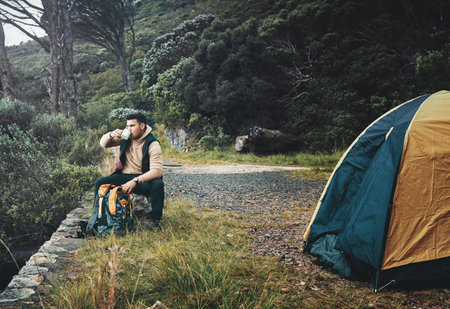Introduction to Portable Stoves for UK Camping
If you’ve ever set out on a British camping adventure, you’ll know there’s nothing quite like the joy of gathering around a warm meal under open skies. In the UK, camping is more than just a pastime—it’s a cherished tradition that brings families and friends together, whether it’s along the Lake District’s misty shores or nestled in the rolling hills of the Cotswolds. However, with our famously unpredictable weather and the need for a reliable hot cuppa after a rainy ramble, having the right portable stove is simply essential. Portable stoves have become an integral part of the British camping experience, offering not only convenience but also the ability to cook hearty meals no matter what the weather throws your way. With so many options available, finding the best stove can feel overwhelming, but choosing wisely ensures your camping trip is both safe and satisfying—rain or shine.
Types of Portable Stoves Commonly Used in Britain
When planning a camping trip in the UK, choosing the right portable stove is essential for a safe and enjoyable experience. British campsites commonly see a few key types of stoves, each with its own strengths and quirks, often referred to by familiar local terms. Understanding these options can help you select the best fit for your family’s outdoor adventures.
Popular Stove Types on British Campsites
| Stove Type | Description | Typical Usage | Local Terminology |
|---|---|---|---|
| Gas Stoves | Easy to use, quick to ignite and control; usually run on small butane or propane canisters (often called “camping gas”) | Ideal for family campers seeking convenience and speed; widely available in outdoor shops across the UK | Camping Gas Stove, Canister Stove |
| Solid Fuel Stoves | Simple design using fuel tablets or blocks (such as Hexamine); lightweight and compact but slower to cook with | Popular among Duke of Edinburgh Award participants and hikers due to their light weight and simplicity | Hexi Stove, Solid Fuel Burner |
| Multi-Fuel Stoves | Versatile option that burns various fuels including petrol, paraffin, or methylated spirits (“meths”); can be used almost anywhere | Favoured by seasoned campers and wild campers who need flexibility in remote locations | Trangia (spirit burner), Multi-Fuel Cooker |
Understanding Local Preferences and Safety Tips
While gas stoves remain the most popular choice for families due to their ease of use, British adventurers also value solid fuel stoves for lightweight expeditions and multi-fuel stoves for versatility during longer trips. It’s important to note that many UK campsites have specific safety rules around open flames and fuel storage—always check ahead before packing your kit. Whether you’re brewing a morning cuppa or rustling up beans on toast, knowing your stove types will help ensure a warm meal and happy campers all round!
![]()
3. Key Considerations: UK Regulations and Campsite Rules
Before packing your portable stove for a British camping adventure, it’s essential to understand the key regulations and campsite rules that keep everyone safe. The UK has specific safety standards when it comes to outdoor cooking equipment, with regulations set by the British Standards Institution (BSI) to ensure all stoves meet fire safety and fuel efficiency requirements. Many campsites across England, Scotland, Wales, and Northern Ireland will only allow stoves that have a clear CE or UKCA mark, indicating compliance with these rigorous standards.
Understanding Campsite Policies
Each campsite can have its own set of rules regarding which types of stoves are permitted. While some family-friendly sites welcome gas, liquid fuel, or solid fuel stoves, others may restrict open flames entirely due to fire risks—especially during dry summer months. Always check with your chosen site ahead of your visit; many will list approved stove types on their website or provide guidance upon booking.
Fuel Availability in the UK
The availability of different fuels is another important factor. Butane and propane gas canisters are widely available at outdoor retailers, petrol stations, and even some supermarkets throughout Britain. Methylated spirits and solid fuel tablets are also common but may be harder to find in remote rural areas. If you’re planning a trip to the countryside or national parks, consider stocking up in advance to avoid disappointment.
Family Safety Tips
For parents and caregivers camping with children, it’s wise to choose stoves that have built-in safety features such as stable bases, flame controls, and automatic shut-off mechanisms. Always supervise little ones near the cooking area and follow campsite advice on safe operation and storage. By respecting both official regulations and campsite rules, you’ll ensure a worry-free mealtime experience under the British sky.
4. Comparing Top Portable Stove Brands Popular in the UK
When it comes to camping across the picturesque British countryside, choosing a reliable portable stove can make or break your outdoor experience. Here, we’ll highlight and compare some of the most trusted stove brands and models that British campers frequently pack for their adventures. We’ll cover what makes each one stand out, as well as any drawbacks you should consider.
Popular Portable Stove Brands Among British Campers
| Brand & Model | Key Features | Pros | Cons |
|---|---|---|---|
| Campingaz Camp Bistro 2 | Piezo ignition, compact design, uses butane canisters | Easy to use, widely available gas refills, budget-friendly | Not ideal for very windy conditions, single burner only |
| Trangia 27-2 UL | Alcohol burner, lightweight aluminium construction, includes pots and pans | Exceptionally durable, works in cold weather, no need for pressurised gas | Slight learning curve for beginners, slower cooking times |
| Coleman Fyrestorm PCS | All-in-one system with wind protection, compatible with various fuels | Excellent in windy conditions, rapid boiling, versatile fuel options | Heavier than some rivals, pricier than basic stoves |
| Jetboil Flash Cooking System | Integrated cooking cup, push-button igniter, fast boil time | Boils water in under 2 minutes, very compact, minimal setup required | Mainly for boiling water (limited cooking versatility), specific fuel canisters needed |
| Kampa Hottie Portable Gas Heater/Stove Combo | Doubles as a heater and stove, piezo ignition, uses butane cartridges | Keeps you warm on chilly UK evenings, multipurpose functionality | Larger footprint on campsite table, heavier to carry on long treks |
Choosing the Right Stove for Your Family Adventure
The best portable stove for your camping trip depends on your family’s needs: Are you looking for simplicity? The Campingaz Camp Bistro 2 is a reliable classic. For adventurous families who enjoy hiking and want something lightweight and robust, Trangia’s models are hard to beat. If speed and wind-resistance are priorities—especially when dealing with unpredictable British weather—the Jetboil Flash or Coleman Fyrestorm may be just what you need.
A Few Handy Tips from Seasoned British Campers:
- If your campsite is exposed or breezy (think Lake District or Scottish Highlands), prioritise stoves with good wind protection.
- If you’re camping with children and need quick hot drinks or meals on demand, rapid-boil systems like Jetboil are a real time-saver.
- If you value multi-functionality—heating and cooking together—the Kampa Hottie is a great companion for cooler nights under canvas.
A Final Thought:
No matter which brand you choose, always check fuel availability locally before heading out. British campsites often have limited shop supplies—planning ahead keeps everyone happy and well-fed!
5. Real-Life Testing: Performance in Typical British Conditions
If you’ve ever set up camp in the Lake District or pitched a tent on the windswept Cornish coast, you’ll know that British weather is famously unpredictable. To truly determine which portable stove suits UK campsites best, we put these stoves to the test in conditions that British campers know all too well: persistent drizzle, gusty winds, and those crisp evenings when your breath forms clouds in the air.
Damp Conditions
Rain is almost a given on any camping trip here. We tried three top-rated stoves during a particularly soggy weekend in Snowdonia. The canister gas stove fired up quickly despite moisture in the air, while the traditional meths burner took noticeably longer to get going. Our multi-fuel option was reliable but required a bit of extra shielding from wind-blown rain—placing it behind a rock worked wonders.
Windy Weather
On the blustery hills of Yorkshire, wind resistance became the true test. The integrated windshield design on one modern gas stove kept our water boiling steadily for tea time, while an older, open-frame model struggled, with flames frequently flickering out. We found that having a low-profile stove or built-in wind protection made all the difference between a quick cuppa and a frustrating wait for warm water.
Chilly Evenings
Nothing beats gathering the family around for hot chocolate after a long day outdoors—but cold air can sap heat from your stove. In chilly Scottish glens, we noted that stoves with better insulation and wider burner heads boiled water faster and more evenly. Those without proper insulation took much longer, leaving us shivering as we waited for supper.
Practical Tips from the Field
From our testing, we recommend always packing a simple windbreak and storing fuel canisters somewhere slightly warmer overnight (like inside your sleeping bag’s foot area) to ensure reliable ignition come morning. It’s these small tweaks that make campsite cooking less stressful—even when Mother Nature throws her worst at you.
So whether you’re introducing your little ones to their first camping breakfast or sharing stories over late-night marshmallows, choosing a stove that stands up to Britain’s unique climate will keep everyone warm, well-fed, and smiling—rain or shine.
6. Eco-Friendliness and Leave No Trace: British Values
Eco-consciousness is deeply woven into the fabric of British camping culture, with many families and outdoor enthusiasts committed to preserving the countryside for future generations. When comparing portable stoves for use on UK campsites, it’s important to consider how each option aligns with the principle of “Leave No Trace”—a philosophy that encourages campers to minimise their impact on the environment.
Sustainability Matters in the Great British Outdoors
For UK campers, sustainability isn’t just a buzzword; it’s about respecting local wildlife, protecting ancient woodlands, and ensuring that our cherished landscapes remain unspoiled. Portable stoves play a key role here. Gas canister stoves are popular for their convenience, but single-use cartridges can contribute to landfill waste unless they’re recycled responsibly. On the other hand, liquid fuel stoves often have refillable tanks, reducing disposable waste, though proper handling is crucial to avoid spills.
Alternative Options for Green Camping
Increasingly, eco-minded families are exploring alternatives such as wood-burning stoves designed to operate efficiently with minimal smoke and residue. These stoves allow campers to use fallen twigs or natural debris—just be sure to follow campsite rules and collect only deadwood where permitted. Some models even include features like ash trays or built-in spark arrestors, offering safer and cleaner combustion.
The British Way: Responsible Stove Use
Ultimately, choosing the best portable stove for your family adventure means balancing convenience with environmental responsibility. Look for stoves that support refillable fuels, produce minimal emissions, and leave no trace of your stay. By making thoughtful choices, UK campers can help ensure that our green spaces continue to thrive—and that every outdoor meal becomes a lesson in sustainability for young explorers.
7. Conclusion: Choosing the Right Portable Stove for Your British Adventure
After exploring the different types of portable stoves, their features, and what to consider for campsite cooking in the UK, it’s clear that there’s no single “best” option for every family or camping group. The right stove depends on your unique needs, whether you’re heading to a family-friendly site in the Lake District, a remote Scottish glen, or a coastal Cornish hideaway.
Final Recommendations
For families prioritising safety and ease of use, canister gas stoves are often the top pick—compact, reliable, and quick to set up. If sustainability and fuel availability matter most (especially for longer adventures), a multi-fuel stove could be your ideal companion. For those who cherish traditional British camping with a touch of nostalgia, spirit burners or wood-burning stoves offer both atmosphere and function, though they require extra care and attention.
Key Points to Remember
- Always check campsite regulations before packing your stove—some have restrictions on open flames or certain fuel types.
- Consider Britain’s unpredictable weather; wind shields and stable designs help keep mealtimes stress-free even when it’s blustery.
- Prioritise safety: teach children about hot surfaces, always supervise cooking, and keep a safe distance from tents and flammable materials.
Encouragement for Safe and Happy Camping
No matter which portable stove you choose, the real magic lies in those shared moments—brewing tea at sunrise or sizzling sausages after a long day exploring. By making an informed choice and respecting both safety guidelines and local rules, you’ll ensure many memorable—and delicious—camping trips across Britain. Happy adventuring!


